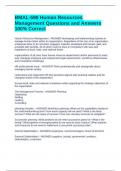BMAL-590 Human Resources
Management Questions and Answers
100% Correct
Human Resource Management - ANSWER-developing and implementing systems to
manage human talent within an organization. Regardless of the size of an organization,
employees have to be recruited, engaged, retained, developed and trained, paid, and
provided with benefits. All of which must be done in compliance with laws and
regulations at local, state, and national levels.
organizations of all sizes have human resource departments and/or personnel to meet
ever changing employee and employment legal requirements, workforce effectiveness
and competitive challenges
HR professionals must: - ANSWER-Think systematically and strategically about
managing human assets.
Understand and implement HR best practices aligned with practical realities and the
changing needs of the organization.
Ensure local, state and national compliance while supporting the strategic objectives of
the organization.
The Management Process - ANSWER-Planning
Organizing
Staffing
Leading
Controlling
planning includes: - ANSWER-Workforce planning: What are the capabilities needed in
the short/medium/long term? How much capacity will we need? What is the likely
turnover? What are the types of turnover? How can voluntary turnover be mitigated?
Succession planning: What positions do we need succession plans for? What is the
timing? What pipeline of emerging talent do we need to have in place? What systems
and resources do we need to implement a successful succession plan?
Internal Stakeholders - ANSWER-employees, owners/managers, board of directors
External Stakeholders - ANSWER-suppliers, society, government, creditors,
shareholders, customers
,A survey by the U.S. Small Business Association identified significant concerns in small
organizations including: - ANSWER-Finding qualified/skilled workers
Increasing costs of employee benefits
Payroll taxes
Compliance with governmental regulations
All of these have an HR focus and demonstrate the need for appropriate HR expertise
and capacity in all organizations regardless of size.
HR's Role in the Organization: - ANSWER-Participate in developing an organization's
business strategy
Align HR strategy to organizational strategy
Support other functions in their strategic roles
HR interacts with all other departments in an organization: - ANSWER-strategically,
operationally and administratively.
Society for Human Resource Management (SHRM) - ANSWER-The world's largest
professional association devoted to human resource management. The Society's
mission is to serve the needs of HR professionals by providing the most essential and
comprehensive resources available as well as to advance the human resource
profession by ensuring that HR is recognized as an essential partner in developing and
executing organizational strategy.
The 9 competency areas are: - ANSWER-HR knowledge
Ethical practice
Leadership and navigation
Business acumen
Consultation
Critical evaluation
Communication
Global and cultural effectiveness
Relationship management
HR knowledge - ANSWER-the understanding and application of principles, practices,
and functions of effective human resource management. This includes strategic
business management, workforce planning, risk management, employee and labor
relationship, compensation and benefits, HR technology, talent management, and
change management.
Ethical practice - ANSWER-the ability to integrate core values, integrity, and
accountability through all organization and business practices. This includes skills such
as building trust, rapport, and credibility; displaying professionalism; and demonstrating
personal and professional integrity.
, Leadership and navigation - ANSWER-The ability to direct and contribute to initiatives
and processes within the organization. This includes transformational and functional
leadership, goal orientation and results, succession planning, project management,
change management, political savvy, and consensus building.
Business acumen - ANSWER-the ability to understand and apply information to
contribute to the organization's strategic plan. This includes strategic agility, business
knowledge, systems thinking, economic awareness, sales, marketing, finance &
accounting knowledge, knowledge of technology, labor market, government and
regulatory guidelines, and organizational metrics.
Consultation - ANSWER-the ability to provide guidance to organizational stakeholders.
This includes coaching, project management, analytic reasoning, problem solving,
inquisitiveness, creativity and innovation, flexibility, career pathing, people
management, and time management.
Critical evaluation - ANSWER-the ability to interpret information to make business
decisions and recommendations. This includes measurement and assessment skills,
objectivity, critical thinking, problem solving, research methodology, auditing skills, and
knowledge management.
Communication - ANSWER-the ability to effectively exchange information with
stakeholders. This includes verbal, written and presentation skills, persuasion,
diplomacy, objectivity, listening, feedback, facilitation, social media technology and
savvy, and public relations.
Selecting Employees to Fit the Job and the Organization: - ANSWER-Selecting and
implementing an appropriate selection/decision making strategy. Sorting and ranking
applicants who fit the criteria of the job and the culture of the organization.
Training and Developing a Competitive Workforce: - ANSWER-Ensuring that employees
possess the knowledge and competencies needed to be proficient in their jobs.
Providing ongoing coaching/mentoring for long term employee development.
Developing an Approach to Total Compensation: - ANSWER-Providing base
wages/salary, incentive pay and benefits for employees in exchange for their work
performed for the organization.
Global and cultural effectiveness - ANSWER-the ability to value and consider the
perspectives and backgrounds of all parties. This includes global and diversity
perspectives, openness to various perspectives, empathy, tolerance for ambiguity,
adaptability, and cultural awareness and respect.
Relationship management - ANSWER-the ability to manage interactions to provide
service and support the organization. This includes business networking expertise,




